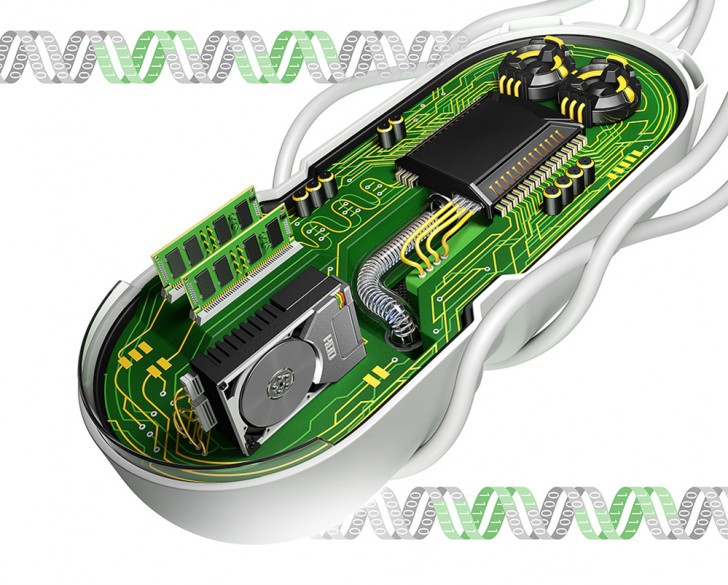Despite what the name might suggest, synthetic biology is not about creating artificial life. Instead, it focuses on scouring nature for components that can be used to build efficient biological production systems. Many research groups in Belgium are working on unravelling nature’s toolkit, but their efforts have remained scattered. At Ghent University, three researchers have recently entered into a formal collaboration at the Centre for Synthetic Biology. By associating with other Belgian research groups, they aspire to create a national platform to exchange knowledge and drive the field forward.
Biotech Lego
“Researchers have been manipulating micro-organisms to produce interesting compounds for decades,” Tom Desmet of the recently founded Centre for Synthetic Biology (CSB) says. “But forcing an organism to dedicate its resources to the production of a single product is pretty difficult. Synthetic biology uses a bottom-up approach based on building production pathways from scratch. These biological buildings blocks can be combined in different ways, from isolated enzymes to different cell types. However, the ultimate goal is creating an artificial cell with a minimal genetic household, including the synthetic pathway of the molecule of interest.”
“At the moment, synthetic biology is still mostly a concept,” Desmet admits. “We are seeing a boom in publications, journals, and conferences, but we are still at the beginning of the journey. How do you create an empty cell? What is the minimal genome needed? Creating new tools, such as synthetic transcription factors or libraries of promotors, will be the focus for the coming 5 to 10 years.”
Centralizing Belgian expertise
While the concept is being built from the ground up, practical applications still rely on optimizing the complexity present in existing micro-organisms. Three researchers at Ghent University were initially working on complementary domains within synthetic biology, but they have decided to work more closely together. Tom Desmet is active in enzyme discovery and development, providing the right catalysts to do the reaction. Marjan De Mey integrates these enzymes in a metabolic pathway in which they become part of a flux system that leads to the end product. Inge Van Bogaert specializes in membrane transport, enabling substrates to enter the cell and the product to be excreted. “When these three aspects are matched, you get a fully integrated production system,” Desmet says. “Joining forces allows us to provide a broader expertise to potential partners.”
“At the same time, it is an opportunity to expand this collaboration to other Belgian researchers in the field of synthetic biology,” Desmet continues. “There is a lot going on, but efforts have remained scattered. By associating with these groups, we can create a national platform, similar to those present in other countries and that form a European synthetic biology network.” The CSB has already set up some early collaborations, such as those with Alain Goossens of the VIB. “Alain is an expert in the metabolic engineering of plant cells. He is also developing synthetic biology tools, and it allows us to find inspiration in other parts of nature,” Desmet says. “We are in contact with some other labs from Ghent and Brussels. The idea is to focus more intensively on new partnerships in 2018 using various strategies, such as organizing a kick-off event open to everyone.”
From concept to applications
“You can dream big, but in reality, the further you go from biological molecules, the more difficult it will become to create them using a synthetic biology approach,” Desmet says. “The first successes will be natural products and bio-active molecules such as new generations of antibiotics or natural metabolites that are modified or more efficiently produced.” At CSB, one of the initial targets is the bottom-up production of chito-oligosaccharides with a well-defined structure. The chitin degradation products obtained from shellfish have many interesting applications, from wound healing to plant protection. “Through degradation, you obtain a complex mixture, where every component has its own effect,” Desmet explains. “By creating E. coli strains that are capable of efficiently producing chito-oligosaccharides with a specific length and acetylation pattern, these effects can be more defined. The fact that we can make these very selectively through a bottom-up approach makes this a very high-tech project that can only be completed with the newest molecular techniques.”
In search of a better name?
While synthetic biology is mostly focussed on technology development, the industry has also discovered the field. Spin-off companies are being founded worldwide that commercialize new molecular tools. Biotech and pharmaceutical companies are also intrigued to apply this, but have some reservations about the name of the field. While it is clear that the goal is not to play God by creating new life, and that the production strains cannot survive outside of the lab, those involved in synthetic biology should be careful how the technology is marketed. Just like in the GMO discussion, the consensus is that once somebody mentions Frankenstein, it will become a lot harder. Given the potential, this is a risk that should not be taken lightly.
*Image credit: Liang Zong & Yan Liang / MIT


